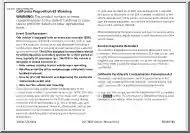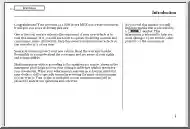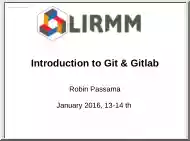No comments yet. You can be the first!
What did others read after this?
Content extract
Source: http://www.doksinet Acute myocardial infarction and unstable angina (acute coronary syndrome) Istvan Edes DEOEC, Department of Cardiology Debrecen Source: http://www.doksinet Definition of myocardial infarction (MI) Clinical entity which is associated with ischemic chest pain and/or dyscomfort and subsequent myocyte necrosis. Typically associated with: - ECG changes - elevation of markers for myocyte necrosis (TnI, TnT, CK and CK-MB) Clinical forms of MI: With or without ST elevation Q or non-Q transmural or subendocardial Source: http://www.doksinet Definition of unstable angina (UA) Specific form of CAD that is associated with increased risk of cardiac death and MI and characterized by the following: - Lack of ECG and enzymatic changes typical for Q-wave MI - Most common cause of UA is reduced myocardial perfusion caused by nonocclusive thrombus - Less common causes: dynamic obstruction, tissue proliferation (restenosis), inflammation, and secondary unstable angina
(anemia, hyperthyreodism, infection, etc.) Source: http://www.doksinet Source: http://www.doksinet Characteristics of acut coronary syndrome Unstable angina NSTEMI STEMI Plaque rupture ++++ ++++ ++++ White thrombus ++++ ++++ ++++ + +++ ++++ Red thrombus Source: http://www.doksinet Plaque rupture and thrombosis Intraluminar thrombus Appositional thrombus Direction of blood stream Lipid Intraplaque thrombus Source: http://www.doksinet Source: http://www.doksinet Platelet aggregation (white thrombus) Davies MJ, MD. London, UK Source: http://www.doksinet Source: http://www.doksinet The most important clinical indicator in acute coronary syndrome is the presence or absence of ST elevation! 1) ST elevation absent: treat as unstable angina 2) ST elevation present: treat as acute MI (STEMI) The important difference in treatments is the acute administration of systemic thrombolysis and/or primary PTCA in STEMI Source: http://www.doksinet Pathophysiology
of UA 1) UA is usually associated with severe occlusive coronary artery disease (angina may be provoked by different conditions that increase the O2 consumption of the myocardium - tachycardia, arrhythmia stb.) 2) Patological events during angina are as follows: hypoxia - ST segment depression - pain - tachycardia and/or hypertension 3) Role of inflammation (infection) is controversial - cytokines, metalloproteases, chlamydia, helicobacter 4) Platelet aggregation - partial thrombosis - vasoconstriction Source: http://www.doksinet Pathophysology of acute MI 1) Usually associated with intracoronary obstructiv (intraplaque and appositional) red thrombus. 2) Patological events during acute MI are as follows: hypoxia/anoxia - ST segment elevation - pain – tachycardia/ bradycardia and/or arrhythmia and/or pump failure 3) Important necrotic markers: Troponin T/I CK-MB Myoglobin Source: http://www.doksinet Treatment of UA I. Bed rest with continous ECG monitoring: Supplemental O2,
sedatives (morphine iv.), IABP (if necessary – hemodynamic instability) Iv. drugs: nitrate (molsidomin), heparin Oral drugs: aspirin ß-blockers ACE-inhibitors Ca2+ channel antagonists? (in combination? If ß-blockers are contraindicated?) Invasive treatment (risk stratification): urgent or early PTCA, stent, CABG Source: http://www.doksinet Treatment of UA II. Aspirin: 175-325 mg/day (enterosolvent forms) Clopidogrel: 75 mg/day (in combination! CURE study) Ticlopidin: clopidogrel has a better pharmacodynamic and safety profile Heparin: 5000-10000 U initial dose, maintenance dose 500-1500 U/h (aPTT 2-2.5x of control) Nitrate: 1-10 mg/h iv. (RR control, >90 Hgmm) Nitrate tolerance! ß-blockers: low initial dose iv. (5-15 mg) metoprolol, followed by 2x25/100 mg/day, bisoprolol 2,5-5 mg ACE inhibitors: low initial dose ramipril, perindopril, enalapril Source: http://www.doksinet Treatment of UA III. Newly developed drugs: Drugs to influence myocardium metabolism - trimetazidin
(further evidences required) LMWH (low molecular weight heparin) (enoxiparin is preferred if no CABG is planned - more expensive than UFH) IIb/IIIa inhibitors (abciximab, eptifibatide, tirofiban) – high risk patients – Troponins +) (expensive – bleeding complications) Trombin inhibitos (hirudin? few evidence yet) Source: http://www.doksinet Treatment of acute MI – prehospital phase 1) 30-50% of the patient is lost in the first hour of the infarction due to arrhythmia. 2) Prehospital systemic thrombolysis: only if the time of transfer to hospital is >90 minutes. The primary PTCA further complicates the prehospital thrombolysis (no streptokinase). 3) The 12 channel ECG, introduction of iv. canula, administration of aspirin and nitrate are the integral parts of the prehospital phase. Source: http://www.doksinet Treatment of acute MI – hospital phase I. Bed rest with continous ECG and hemodynamic monitoring: supplemental O2, sedatives (morphine iv.), IABP (if necessary
– hemodynamic instability) Nitrate: 1-10 mg/h iv. (RR control, >90 Hgmm) Nitrate tolerance! Aspirin: 175-325 mg/day (enterosolvent forms) – the vascular risk is lowered from 14.4% to 106% after 1 month ß-blockers: low initial dose iv. (5-15 mg) metoprolol, followed by 2x25/100 mg/day, bisoprolol 2,5-5 mg. Source: http://www.doksinet Treatment of acute MI – hospital phase II. ACE-inhibitors: inhibition of LV remodeling - ramipril, captopril, enalapril, lisinopril. Low initial dose – gradual increase in dose. Ca2+ channel blockers: only if ß-blockers are not tolerated or in severe hypertension (diltiazem, verapamil). Mg2+: no general administration. Only in hypomagnesiemia, hypokalemia, and in „torsaides de pointes” or other arrhythmias. Digitalis: only few selective indications (heart failure, atrial fibrillation). Source: http://www.doksinet Treatment of acute MI – hospital phase III. Systemic thrombolytic treatment: Indication: under the age of 75, if in two
connected ECG leads there are >1mm ST elevation or a newly developed LBBB and the clinical signs of acute MI are present (streptokinase, alteplase, tenecteplase). Major contraindications: stroke within 1 year, active bleeding (except menstruation), aortic dissection, brain tumors, irreversible advanced malignant diseases. Relative contraindications: severe hypertension, recent trauma, active peptic ulcer, allergy, pregnancy. Complications: risk of stroke is increased (3.6/1000 patients) – highest risk is for alteplase. Hypotension, bleeding (05%), allergy (01% - steroid, adrenalin) Source: http://www.doksinet Treatment of acute MI – hospital phase IV. Antithrombotic treatment: For the prevention of deep vein thromb., pulm and arterial emb; to inhibit reocclusion and reinfarction. Indications: -In association with Alteplase -If no systemic thrombolysis is feasible -If there is an increased risk of intracavital (mural) thrombus formation and/or systemic embolisation Available
drugs: -Heparin (aPTT: 2-3), Enoxaparin (1mg/kg) -Syncumar, Warfarin (only in chronic AF, LV aneurysm and in deep vein thrombosis/systemic arterial embolisation – INR:2-3) IIb/IIIa receptor blockers Only if intervention (PTCA) is planned (abciximab, eptifibatide, tirofiban). Mainly reserved for high risk patients. Source: http://www.doksinet Treatment of acute MI – hospital phase V. Invasive treatment: Primary PTCA – treatment of choice if possible (experienced personnal, high tech. eqipments) within 12 hours of the onset of chest pain Significantly better than the systemic thrombolysis (mortality, infarction, stroke). Rescue PTCA – following unsuccesful systemic lysis (after 90 min no decrease in ST elevation and worsening clinical symptoms). Clinical outcome is not as good as for primary PTCA. Combination therapy – half dose of systemic lysis (tPA) and PTCA. No further improvement in clinical outcome (has recently been shown to increase the mortality – ASSENT 4
study). CABG – only if PTCA is not possible or unsuccesful (less than 5% of the cases). Source: http://www.doksinet ACS decision making algorythm ACS Phys. exam, ECG, Blood test No ST elevation Aspirin Nitrate ß-blockers Heparin ACE-inhibitors ST elevation elevated troponins, recurrent ischemia, hemodyn. instabil severe arrhythmia post-MI unstable angina Normal troponins 6 and 12 h No recurrent pain, Minimal ECG changes PTCA (trombolysis) GP IIb/IIIa Coronarogr. Invasive treatment Stress test Medical treatment Regular checkup Source: http://www.doksinet Source: http://www.doksinet Mortality rates in Hungary (Magyar Nemzeti Kardiológiai Fejlesztési Terv) Source: http://www.doksinet Szállítási idő a katéteres laborokba (Magyar Nemzeti Kardiológiai Fejlesztési Terv) Source: http://www.doksinet Source: http://www.doksinet Platelet aggregation Platelet aggregation Platelets Plaque rupture and adhesion Release of agonists Platelet activation Expression
of GP IIb/IIIa Lipid-rich plaque Vessel wall Fibrinogen Source: http://www.doksinet Unstable plaque Falk E et al. Circulation 1995 Source: http://www.doksinet Risk stratification in UA Risk stratification a) Trombotic markers: recurrent pain, severe ECG changes, high troponin T or I levels, presence of trombus (coronarography) b) Clinical markers: age >70 years, previous MI, previous severe angina, diabetes c) Biological markers: elevated C-protein d) Angiographic markers: LV function, severity of coronary disease Source: http://www.doksinet Invasive strategy in UA Indications for coronary angiography: - recurrent angina, severe ischemia, elevated troponin levels, hemodynamic instability, arrhythmia, post-MI unstable angina, diabetes, depressed LV function, post-PTCA patient Source: http://www.doksinet Primer PCI - Hungary 5000 4316 4359 4500 4000 3105 3500 3000 2385 2500 2000 1500 1096 1000 500 0 2002 2003 2004 Intervenciós központok adatai 2005 2006
Nyiregyháza Győr Miskolc Bfüred ZE OGYK Bajcsy Zs.K BIK GOKI DOTE SZOTE POTE SE CVC Source: http://www.doksinet Mortality rates due to MI in Hungary, 2005
(anemia, hyperthyreodism, infection, etc.) Source: http://www.doksinet Source: http://www.doksinet Characteristics of acut coronary syndrome Unstable angina NSTEMI STEMI Plaque rupture ++++ ++++ ++++ White thrombus ++++ ++++ ++++ + +++ ++++ Red thrombus Source: http://www.doksinet Plaque rupture and thrombosis Intraluminar thrombus Appositional thrombus Direction of blood stream Lipid Intraplaque thrombus Source: http://www.doksinet Source: http://www.doksinet Platelet aggregation (white thrombus) Davies MJ, MD. London, UK Source: http://www.doksinet Source: http://www.doksinet The most important clinical indicator in acute coronary syndrome is the presence or absence of ST elevation! 1) ST elevation absent: treat as unstable angina 2) ST elevation present: treat as acute MI (STEMI) The important difference in treatments is the acute administration of systemic thrombolysis and/or primary PTCA in STEMI Source: http://www.doksinet Pathophysiology
of UA 1) UA is usually associated with severe occlusive coronary artery disease (angina may be provoked by different conditions that increase the O2 consumption of the myocardium - tachycardia, arrhythmia stb.) 2) Patological events during angina are as follows: hypoxia - ST segment depression - pain - tachycardia and/or hypertension 3) Role of inflammation (infection) is controversial - cytokines, metalloproteases, chlamydia, helicobacter 4) Platelet aggregation - partial thrombosis - vasoconstriction Source: http://www.doksinet Pathophysology of acute MI 1) Usually associated with intracoronary obstructiv (intraplaque and appositional) red thrombus. 2) Patological events during acute MI are as follows: hypoxia/anoxia - ST segment elevation - pain – tachycardia/ bradycardia and/or arrhythmia and/or pump failure 3) Important necrotic markers: Troponin T/I CK-MB Myoglobin Source: http://www.doksinet Treatment of UA I. Bed rest with continous ECG monitoring: Supplemental O2,
sedatives (morphine iv.), IABP (if necessary – hemodynamic instability) Iv. drugs: nitrate (molsidomin), heparin Oral drugs: aspirin ß-blockers ACE-inhibitors Ca2+ channel antagonists? (in combination? If ß-blockers are contraindicated?) Invasive treatment (risk stratification): urgent or early PTCA, stent, CABG Source: http://www.doksinet Treatment of UA II. Aspirin: 175-325 mg/day (enterosolvent forms) Clopidogrel: 75 mg/day (in combination! CURE study) Ticlopidin: clopidogrel has a better pharmacodynamic and safety profile Heparin: 5000-10000 U initial dose, maintenance dose 500-1500 U/h (aPTT 2-2.5x of control) Nitrate: 1-10 mg/h iv. (RR control, >90 Hgmm) Nitrate tolerance! ß-blockers: low initial dose iv. (5-15 mg) metoprolol, followed by 2x25/100 mg/day, bisoprolol 2,5-5 mg ACE inhibitors: low initial dose ramipril, perindopril, enalapril Source: http://www.doksinet Treatment of UA III. Newly developed drugs: Drugs to influence myocardium metabolism - trimetazidin
(further evidences required) LMWH (low molecular weight heparin) (enoxiparin is preferred if no CABG is planned - more expensive than UFH) IIb/IIIa inhibitors (abciximab, eptifibatide, tirofiban) – high risk patients – Troponins +) (expensive – bleeding complications) Trombin inhibitos (hirudin? few evidence yet) Source: http://www.doksinet Treatment of acute MI – prehospital phase 1) 30-50% of the patient is lost in the first hour of the infarction due to arrhythmia. 2) Prehospital systemic thrombolysis: only if the time of transfer to hospital is >90 minutes. The primary PTCA further complicates the prehospital thrombolysis (no streptokinase). 3) The 12 channel ECG, introduction of iv. canula, administration of aspirin and nitrate are the integral parts of the prehospital phase. Source: http://www.doksinet Treatment of acute MI – hospital phase I. Bed rest with continous ECG and hemodynamic monitoring: supplemental O2, sedatives (morphine iv.), IABP (if necessary
– hemodynamic instability) Nitrate: 1-10 mg/h iv. (RR control, >90 Hgmm) Nitrate tolerance! Aspirin: 175-325 mg/day (enterosolvent forms) – the vascular risk is lowered from 14.4% to 106% after 1 month ß-blockers: low initial dose iv. (5-15 mg) metoprolol, followed by 2x25/100 mg/day, bisoprolol 2,5-5 mg. Source: http://www.doksinet Treatment of acute MI – hospital phase II. ACE-inhibitors: inhibition of LV remodeling - ramipril, captopril, enalapril, lisinopril. Low initial dose – gradual increase in dose. Ca2+ channel blockers: only if ß-blockers are not tolerated or in severe hypertension (diltiazem, verapamil). Mg2+: no general administration. Only in hypomagnesiemia, hypokalemia, and in „torsaides de pointes” or other arrhythmias. Digitalis: only few selective indications (heart failure, atrial fibrillation). Source: http://www.doksinet Treatment of acute MI – hospital phase III. Systemic thrombolytic treatment: Indication: under the age of 75, if in two
connected ECG leads there are >1mm ST elevation or a newly developed LBBB and the clinical signs of acute MI are present (streptokinase, alteplase, tenecteplase). Major contraindications: stroke within 1 year, active bleeding (except menstruation), aortic dissection, brain tumors, irreversible advanced malignant diseases. Relative contraindications: severe hypertension, recent trauma, active peptic ulcer, allergy, pregnancy. Complications: risk of stroke is increased (3.6/1000 patients) – highest risk is for alteplase. Hypotension, bleeding (05%), allergy (01% - steroid, adrenalin) Source: http://www.doksinet Treatment of acute MI – hospital phase IV. Antithrombotic treatment: For the prevention of deep vein thromb., pulm and arterial emb; to inhibit reocclusion and reinfarction. Indications: -In association with Alteplase -If no systemic thrombolysis is feasible -If there is an increased risk of intracavital (mural) thrombus formation and/or systemic embolisation Available
drugs: -Heparin (aPTT: 2-3), Enoxaparin (1mg/kg) -Syncumar, Warfarin (only in chronic AF, LV aneurysm and in deep vein thrombosis/systemic arterial embolisation – INR:2-3) IIb/IIIa receptor blockers Only if intervention (PTCA) is planned (abciximab, eptifibatide, tirofiban). Mainly reserved for high risk patients. Source: http://www.doksinet Treatment of acute MI – hospital phase V. Invasive treatment: Primary PTCA – treatment of choice if possible (experienced personnal, high tech. eqipments) within 12 hours of the onset of chest pain Significantly better than the systemic thrombolysis (mortality, infarction, stroke). Rescue PTCA – following unsuccesful systemic lysis (after 90 min no decrease in ST elevation and worsening clinical symptoms). Clinical outcome is not as good as for primary PTCA. Combination therapy – half dose of systemic lysis (tPA) and PTCA. No further improvement in clinical outcome (has recently been shown to increase the mortality – ASSENT 4
study). CABG – only if PTCA is not possible or unsuccesful (less than 5% of the cases). Source: http://www.doksinet ACS decision making algorythm ACS Phys. exam, ECG, Blood test No ST elevation Aspirin Nitrate ß-blockers Heparin ACE-inhibitors ST elevation elevated troponins, recurrent ischemia, hemodyn. instabil severe arrhythmia post-MI unstable angina Normal troponins 6 and 12 h No recurrent pain, Minimal ECG changes PTCA (trombolysis) GP IIb/IIIa Coronarogr. Invasive treatment Stress test Medical treatment Regular checkup Source: http://www.doksinet Source: http://www.doksinet Mortality rates in Hungary (Magyar Nemzeti Kardiológiai Fejlesztési Terv) Source: http://www.doksinet Szállítási idő a katéteres laborokba (Magyar Nemzeti Kardiológiai Fejlesztési Terv) Source: http://www.doksinet Source: http://www.doksinet Platelet aggregation Platelet aggregation Platelets Plaque rupture and adhesion Release of agonists Platelet activation Expression
of GP IIb/IIIa Lipid-rich plaque Vessel wall Fibrinogen Source: http://www.doksinet Unstable plaque Falk E et al. Circulation 1995 Source: http://www.doksinet Risk stratification in UA Risk stratification a) Trombotic markers: recurrent pain, severe ECG changes, high troponin T or I levels, presence of trombus (coronarography) b) Clinical markers: age >70 years, previous MI, previous severe angina, diabetes c) Biological markers: elevated C-protein d) Angiographic markers: LV function, severity of coronary disease Source: http://www.doksinet Invasive strategy in UA Indications for coronary angiography: - recurrent angina, severe ischemia, elevated troponin levels, hemodynamic instability, arrhythmia, post-MI unstable angina, diabetes, depressed LV function, post-PTCA patient Source: http://www.doksinet Primer PCI - Hungary 5000 4316 4359 4500 4000 3105 3500 3000 2385 2500 2000 1500 1096 1000 500 0 2002 2003 2004 Intervenciós központok adatai 2005 2006
Nyiregyháza Győr Miskolc Bfüred ZE OGYK Bajcsy Zs.K BIK GOKI DOTE SZOTE POTE SE CVC Source: http://www.doksinet Mortality rates due to MI in Hungary, 2005




